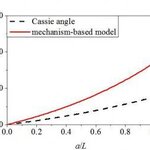Chemistry

A research team has tested a popular zinc hypothesis in paleo-ocean chemistry and concluded it is false.
The fossil record indicates that eukaryotes, single-celled and multicellular organisms with more complex cellular structures compared to prokaryotes, such as bacteria, show limited morphological and functional diversity before 800-600 million years ago.
Some researchers attribute the delayed diversification and proliferation of eukaryotes, which culminated in the appearance of complex animals about 600 million years ago, to very low levels of the trace metal zinc in seawater. As it is for…

Rose madder, a natural plant dye once prized throughout the Old World to make fiery red textiles, might be cool once again.
Chemists have developed a non-toxic and sustainable lithium-ion battery powered by purpurin, a dye extracted from the roots of the madder plant (Rubia species).
Over 3,500 years ago, civilizations in Asia and the Middle East first boiled madder roots to dye fabrics in orange, pink and red but the climbing herb might also lay the foundation for an eco-friendly alternative to traditional lithium-ion (Li-ion) batteries in the 21st century. Lithium-ion batteries…

One way to clean up hazardous heavy metals like arsenic, lead and mercury in contaminated materials could be to use waste from the processing and canning of onions (Allium cepa L.) and garlic (Allium sativum L.)
Biotechnologists Rahul Negi, Gouri Satpathy, Yogesh Tyagi and Rajinder Gupta of the GGS Indraprastha University in Delhi studied the influence of acidity or alkalinity, contact time, temperature and concentration of the different materials present to optimize conditions for making a biological heavy metal filter for industrial-scale decontamination.
They found that at 122 degrees…

Teflon is popular, used on everything from cooking pans to armor-piercing bullets, but it has a waste byproduct, fluoroform, which has to be stored by chemical companies because it has an estimated global warming potential 11,700 times higher than carbon dioxide.
USC scientists are patenting a way to use the ozone-destroying greenhouse gas and transform it into reagents for producing pharmaceuticals. G.K. Surya Prakash , a professor of chemistry at USC and director of the USC Loker Hydrocarbon Research Institute, describes fluorine as "the kingpin of drug discovery." About 20 to 25…

The world's smallest reaction chamber has a mixing volume that can be measured in femtoliters - that's a million billionths of a liter.
The reaction chamber actually consists of nothing more than a tiny spray of liquid, produced by a technique known as electrospray ionization, in which a liquid is converted into lots of charged droplets by exposing it to a high voltage as it exits the nozzle of a thin capillary.
Like water being sprayed out of a hose, these charged droplets form a cone shape, known as a Taylor cone, as they are emitted from the nozzle. Because the electrospray process…

Chemists have been using
the SPring-8 synchrotron at the Japan Synchrotron Radiation Research Institute
to get a detailed look at enzymes that could help power the green economy.
One option for powering clean, environment friendly vehicles is to run them on hydrogen fuel rather than carbon-based fuels. Cheap catalysts to prepare hydrogen gas (H2) are a necessity if this future "hydrogen economy" is to become a reality.
Current man-made catalysts are based on platinum, a rare and precious metal. However, living cells contain enzymes called hydrogenases, based on the abundant metals…

The wetting model is a classical problem in surface and biomimetic science. Wettability is determined by the balance between adhesive and cohesive forces, adhesive which is when a liquid tries to spread on a surface and cohesive when it forms into a ball.
The resultant between adhesive and cohesive forces is called the contact angle. As the tendency of a drop to spread out over a surface increases, the contact angle decreases, making the contact angle an inverse measure of wettability.
There are two classical models to examine the macroscopic contact angle on a rough or…

Researchers have unveiled a new way to use sunlight to produce steam and other vapors without heating an entire container of fluid to the boiling point. The research could lead to inexpensive, compact devices for purification of drinking water, sterilization of medical instruments and sanitizing sewage.
Metallic nanoparticles - so small that 1,000 would fit across the width of a human hair - absorb large amounts of light, resulting in a dramatic rise in their temperature. That ability to generate heat has fostered interest among scientists in using nanoparticles in a range of…

The Price Revolution in Europe, the runaway inflation that occurred during the years between 1515 to 1650, has been attributed to the sudden influx of silver from Mexico and Peru after discovery of the New World, which led to the decline in the value of of silver, and the growth of the European population and therefore competition for goods, which drove up prices.
Analysis of silver, copper, and lead isotope abundances in English coinage from the years 1550-1650 does show the dominance of silver from Europe and Mexico, but also shows a remarkably small contribution from Peru. That…

The yeast used to make beer has yielded what may be the first gene for beer foam, CFG1, scientists are reporting in a new study. The discovery opens the door to new possibilities for improving the frothy "head" so critical to the aroma and eye appeal of the world's favorite alcoholic beverage, beer. And it gives Science 2.0 another reason to write about beer.Tomás G. Villa and colleagues explain that proteins from the barley and yeast used to make beer contribute to the quality of its foam (read more about beer foam and foam-stabilizing materials and terms like proteolysis here). The foamy…